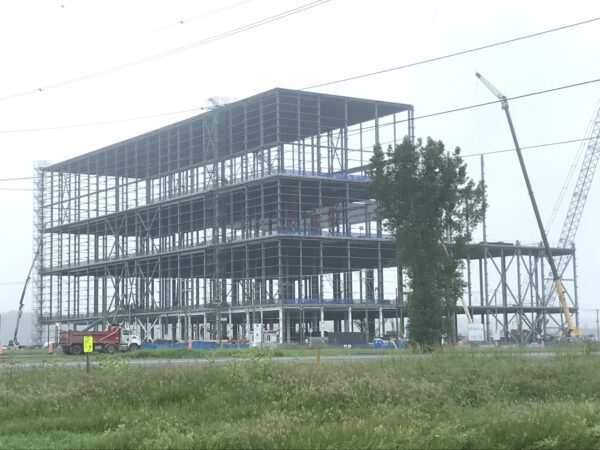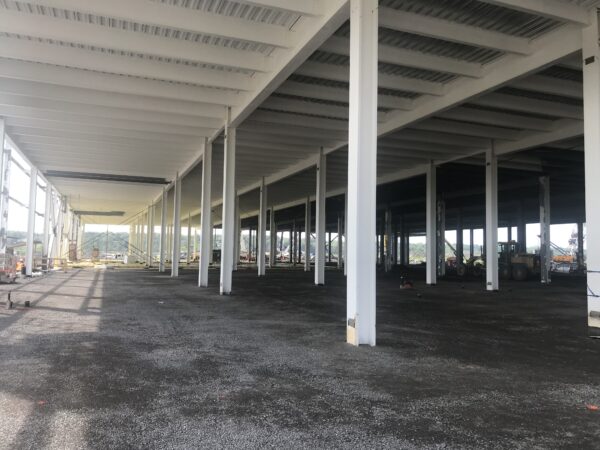
Building Canada’s EV manufacturing epicenter
by Jonathan Lejour, Pedro Escudero and Andy Rathod
Before GM can begin manufacturing lithium-ion batteries in North America, crews must build a lithium processing factory in Quebec.

Photo: Carboline.
On bottomlands beside the St. Lawrence River opposite Trois-Rivieres in Quebec, a large new factory is taking shape.
General Motors, in partnership with POSCO Future M, is building its first North American cathode active materials (CAM) facility in Becancour. These materials are essential components of electric vehicle batteries, so this facility will play an important role in GM’s EV production.
And GM isn’t the only automaker whose EV aspirations brought them to southern Quebec. In the very same Becancour industrial park, a consortium led by Ford plans to build a CAM facility to serve an identical purpose in its own supply chain.
These events bode well for a region whose economy has traditionally ebbed and flowed with the fortunes of the pulp and paper industry.
Canada’s manufacturing landscape is about to change. But first, the facilities must be built.
This story about structural steel fireproofing proves it’s easier said than done. And yet, it’s getting done.
Intumescent fireproofing product selection
Aside from national and provincial building codes that mandate it, protecting steel structures is crucial because EV battery manufacturing involves combustible materials.
Pomerleau, the general contractor, has set an aggressive construction schedule that allocated just 10 weeks to apply over 50,000 gallons of intumescent fireproofing to structural steel. This timeline had a major influence on product selection.
The fast pace of this design-build project meant that shop application of fireproofing was not feasible. The method has its merits but has three drawbacks in this context.
First, sprayers in the shop must leave uncoated the areas where columns or beams connect. That means a field application is necessary after steel is erected. Second, that secondary field application of two-component epoxy products is comparatively slow and difficult owing to added equipment and application requirements. And third, shop application often involves additional transportation loads—and the costs and timeline risks that accompany them—before site delivery and erection due to the added weight of the intumescent fireproofing materials.
Under this very tight schedule, field application of a single-component product was chosen.
Then it was a matter of choosing the ideal field-applied product. Intumescent fireproofing usually is applied in multiple coats for best performance, but the amount of film build and time required between coats is a significant driver of the specification decision.
Carboline’s Thermo-Sorb VOC, a single-component solvent-based intumescent, was ultimately specified. Working in its favor is a long history of strong performance, including the recent construction of a very large EV manufacturing facility in Texas.
The product’s characteristics include a fast recoat window that meant crews could spray its second coat the same day as the first. And, as a single-component system, its comparative simplicity of application drove a lower total installed cost. Total installed cost accounts for the per unit price plus labor hours and equipment requirements, and in the case of Thermo-Sorb VOC, the coating contractor could deploy multiple spray guns and associated manpower in two shifts per day.
Thermo-Sorb VOC made the most sense on paper, where conditions are perfect and nothing goes wrong.
It’s a different story on the job site.

Photo: Carboline.
Horrid weather dampens progress
Rainfall in July 2023 broke records across Quebec.
In downtown Montreal, 265 mm of rain fell for the month. In Sherbrooke, it was 310 mm.
Though it was drier by comparison in Becancour—200 mm of rain was recorded at a weather station in Trois-Rivieres—it was still more than enough to cause problems.
Rain fell on the site on 15 of the 31 days in July. In one punishing stretch, from July 9-16, the area was doused in 111.8 mm of rain. It couldn’t have come at a worse time. Crews were in the thick of spraying.
But the technology behind Thermo-Sorb VOC came to the rescue. The non-water soluble product can be applied and properly cure even in semi-exposed settings. And, as stated above, single-component formulas are simpler to apply.
Add to that the prior calculation which justified bringing lots of sprayers and equipment to the site, and the result is stunning:
Crews are back ahead of schedule.
That would put any general contractor in an enviable position. Getting ahead gives them wiggle room. With the weather they’ve been having, that’s worth its weight in gold. Winter comes early to Quebec.
So if this trend continues, if work crews continue to meet, or even beat, the aggressive construction timeline, then Pomerleau will stick a nice feather in its cap and GM could get this crucial facility online sooner.
And when its doors open to workers for the first time, it will be the new high-water mark in Canada’s manufacturing renaissance.
Jonathan Lejour is a Territory Manager for Carboline Global, Inc. Pedro Escudero is an Engineering Sales Manager for Carboline Global, Inc. Andy Rathod is the Business Development Manager for Canada for Carboline Global, Inc. Jonathan, Pedro, and Andy are part of the Carboline team advising on fireproofing product selection and application for this construction project.